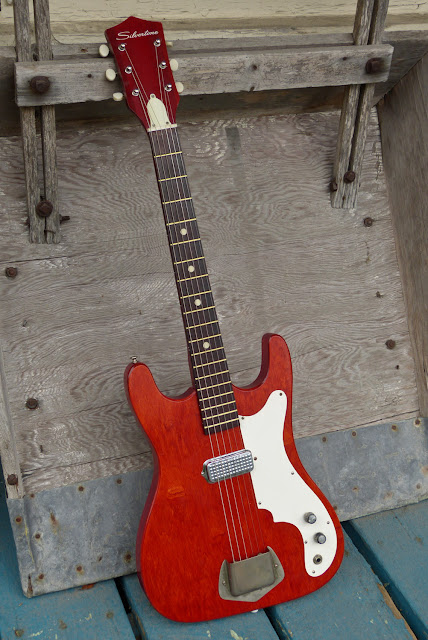1963 Kay-made Silvertone 1410 Electric Guitar
The Sears Silvertone brand covers a lot of ground as far as makers go, though this budget-minded affair (there's a good writeup at Silvertone World on this one) is 100% Kay. It's a solidbody (poplar?) build, lightweight, and long scale (25 3/4") despite having a "snug" feel because of the way the bridge is located almost at the endpin. The DeArmond (presumably) metal-covered pickup has a dark, bluesy, thumpy tone that gives this a lot of body going directly into the amp and while it looks like it's in a "middle" position, bear in mind the bridge location and it's really a neck pickup.
"Modern" features include a bolt-on neck, lightly-radiused rosewood fretboard with jumbo frets, a truss-rod, and adjustable bridge (archtop-style). "Silly" features included (before fixing) a wonky plastic nut, poorly-compensated saddle, no bridge ground, and no side dots. My work on this thus included a new bone nut, a fret level/dress to solve some neck weirdness, drilling and soldering-up a bridge ground, a new rosewood saddle for good intonation (using an unwound G string), and general setup and cleaning. I took photos while I was doing the work so you can see in-process shots at the end of the post.
I (and a few customers who tried it out) confirmed that despite looking low-end, this thing feels awesome. It's a fast, easy player and has a big, thick tone. It's also very clean for its age.
"Modern" features include a bolt-on neck, lightly-radiused rosewood fretboard with jumbo frets, a truss-rod, and adjustable bridge (archtop-style). "Silly" features included (before fixing) a wonky plastic nut, poorly-compensated saddle, no bridge ground, and no side dots. My work on this thus included a new bone nut, a fret level/dress to solve some neck weirdness, drilling and soldering-up a bridge ground, a new rosewood saddle for good intonation (using an unwound G string), and general setup and cleaning. I took photos while I was doing the work so you can see in-process shots at the end of the post.
I (and a few customers who tried it out) confirmed that despite looking low-end, this thing feels awesome. It's a fast, easy player and has a big, thick tone. It's also very clean for its age.
The transparent-red finish looks great!
Here's the guitar right after I started work on it. I've removed the bridge cover and taken the bridge up to find...
...no ground wire to the bridge! That means that this would always have a bit of a continuous hum/buzz when played.
The pickup is riveted to the pickguard.
Here are the adjuster mechanisms for the bridge and the tailpiece removed from its mounting holes.
Here I've located where I want my new drilled holes to come out and I've drilled (carefully) the first one. If you're not 100% paying attention, it's very easy to accidentally drill through your body.
Well, that's done. I know it's a white wire -- at the time I didn't have any red/black to do this job with (I'd just run out).
I try to fix my ground wire to bridges (and thus ground the string-ends) by inserting it into one of the mounting holes for a bridge screw/bolt. This means that there's a secure hold for it.
The last bit was to make a new, compensated, saddle. The bridge had 1/8" compensation before but... it was 1/8" too forward on the mounts and would've never been true on the B&G strings even if it wasn't too forward.






















Comments